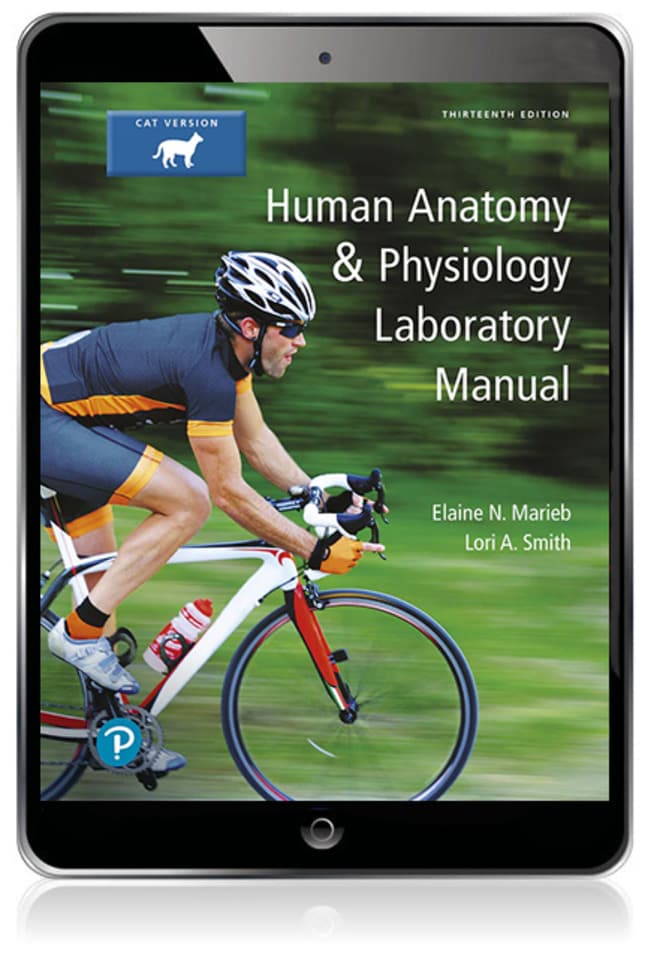
Human Anatomy & Physiology Laboratory Manual, Cat Version, 13th edition
- Elaine N. Marieb
- , Lori A. Smith

- Find it fast
Quickly navigate your eTextbook with search
- Stay organized
Access all your eTextbooks in one place
- Easily continue access
Keep learning with auto-renew
Human Anatomy & Physiology Laboratory Manual features a wide variety of experiments for students concentrating in healthcare programs. Each exercise leads you toward an understanding of the structure and function of the human body. The lab manual uses artwork from Marieb/Hoehn's Human Anatomy & Physiology text, but can accompany any A&P textbook. Available in 3 versions (Main, Cat, Fetal Pig), the Cat and Pig versions respectively include cat and fetal pig dissection exercises.
The 13th Edition includes many new, full-color figures and photos and revamped clinical application and critical thinking questions.
Published by Pearson (July 14th 2021) - Copyright © 2019
ISBN-13: 9780137538263
Subject: Anatomy & Physiology
Category: A&P Lab
- Human Anatomy & Physiology Laboratory Manual, 13th Edition is available in 3 versions: Main, Cat and Fetal Pig.
- Cat and Fetal Pig versions, respectively, include 9 cat and 8 pig dissection exercises that are listed below at the end of the Table of Contents.
Orientation
- Exercise 1. The Language of Anatomy
- Exercise 2. Organ Systems Overview
The Microscope and Its Uses
- Exercise 3. The Microscope
The Cell
- Exercise 4. The Cell: Anatomy and Division
- Exercise 5. The Cell: Transport Mechanisms and Cell Permeability
Histology: Basic Tissues of the Body
- Exercise 6. Classification of Tissues
The Integumentary System
- Exercise 7. The Integumentary System
The Skeletal System
- Exercise 8. Overview of the Skeleton: Classification and Structure of Bones and Cartilages
- Exercise 9. The Axial Skeleton
- Exercise 10. The Appendicular Skeleton
- Exercise 11. Articulations and Body Movements
The Muscular System
- Exercise 12. Microscopic Anatomy and Organization of Skeletal Muscle
- Exercise 13. Gross Anatomy of Muscular System
- Exercise 14. Skeletal Muscle Physiology: Frogs and Human Subjects
The Nervous System
- Exercise 15. Histology of Nervous Tissue
- Exercise 16. Neurophysiology of Nerve Impulses: Frog Subjects
- Exercise 17. Gross Anatomy of the Brain and Cranial Nerves
- Exercise 18. Electroencephalography
- Exercise 19. The Spinal Cord and Spinal Nerves
- Exercise 20. The Autonomic Nervous System
- Exercise 21. Human Reflex Physiology
- Exercise 22. General Sensation
- Exercise 23. Special Senses: Anatomy of the Visual System
- Exercise 24. Special Senses: Visual Tests and Experiments
- Exercise 25: Special Senses: Hearing and Equilibrium
- Exercise 26. Special Senses: Olfaction and Taste
The Endocrine System
- Exercise 27. Functional Anatomy of the Endocrine Glands
- Exercise 28. Endocrine Wet Labs and Human Metabolism
The Circulatory System
- Exercise 29. Blood
- Exercise 30. Anatomy of the Heart
- Exercise 31. Conduction System of the Heart and Electrocardiography
- Exercise 32. Anatomy of Blood Vessels
- Exercise 33. Human Cardiovascular Physiology: Blood Pressure and Pulse Determinations Exercise 34. Frog Cardiovascular Physiology
- Exercise 35. The Lymphatic System and Immune Response
The Respiratory System
- Exercise 36. Anatomy of the Respiratory System
- Exercise 37. Respiratory System Physiology
The Digestive System
- Exercise 38. Anatomy of the Digestive System
- Exercise 39. Digestive System Processes: Chemical and Physical
The Urinary System
- Exercise 40. Anatomy of the Urinary System
- Exercise 41. Urinalysis
The Reproductive System, Development, and Heredity
- Exercise 42. Anatomy of the Reproductive System
- Exercise 43. Physiology of Reproduction: Gametogenesis and the Female Cycles
- Exercise 44. Survey of Embryonic Development
- Exercise 45. Principles of Heredity
Surface Anatomy
- Exercise 46. Surface Anatomy Roundup
PhysioEx™ 9.1 Computer Simulations
- Exercise 1. Cell Transport Mechanisms and Permeability
- Exercise 2. Skeletal Muscle Physiology
- Exercise 3. Neurophysiology of Nerve Impulses
- Exercise 4. Endocrine System Physiology
- Exercise 5. Cardiovascular Dynamics
- Exercise 6. Cardiovascular Physiology
- Exercise 7. Respiratory System Mechanics
- Exercise 8. Chemical and Physical Processes of Digestion
- Exercise 9. Renal System Physiology
- Exercise 10. Acid-Base Balance
- Exercise 11. Blood Analysis
- Exercise 12: Serological Testing
The CAT version of the lab manual includes the following cat dissection exercises:
- Exercise 1. Dissection and Identification of Cat Muscles
- Exercise 2. Dissection of Cat Spinal Nerves
- Exercise 3. Identification of Selected Endocrine Organs of the Cat
- Exercise 4. Dissection of the Blood Vessels of the Cat
- Exercise 5. The Main Lymphatic Ducts of the Cat
- Exercise 6. Dissection of the Respiratory System of the Cat
- Exercise 7. Dissection of the Digestive System of the Cat
- Exercise 8. Dissection of the Urinary System of the Cat
- Exercise 9. Dissection of the Reproductive System of the Cat
The PIG version of the lab manual includes the following additional pig dissection exercises:
- Exercise 1. Dissection and Identification of Fetal Pig Muscles
- Exercise 2. Dissection of the Spinal Cord and Spinal Nerves of the Fetal Pig
- Exercise 3. Identification of Selected Endocrine Organs of the Fetal Pig
- Exercise 4. Dissection of Blood Vessels and Main Lymphatic Ducts of the Fetal Pig
- Exercise 5. Dissection of the Respiratory System of the Fetal Pig
- Exercise 6. Dissection of the Digestive System of the Fetal Pig
- Exercise 7. Dissection of the Urinary System of the Fetal Pig
- Exercise 8. Dissection of the Reproductive System of the Fetal Pig